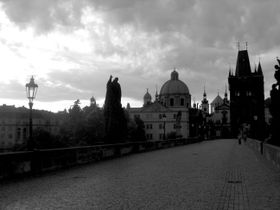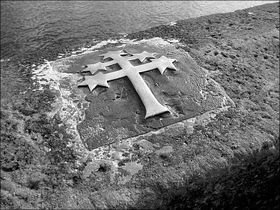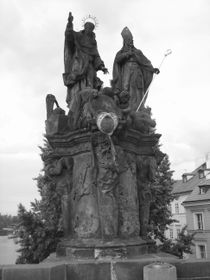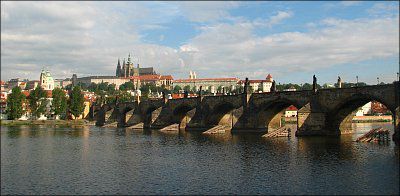 In the year 1357, on the 9th day of the 7th month, Emperor Charles IV was lay the cornerstone to the new bridge. The construction of the bridge had been entrusted to the young master builder Petr Parléř. The bridge's sixteen arches span the Vltava river and for a half a century remained the only connection between the Old City and the Narrow Embankment. The first of the bridge's in total thirty statues was put in place in 1657, the cast iron crucifix which was given a Hebraic inscription in 1696. The second statue was St Nepomuk cast in Nürnberg in 1683 and soon afterwards a whole Nepomuk-cult extended over all of Europe. Since that time innumerable statues of the saint guard bridges and crossings proclaim his martyrdom on Charles Bridge.
In the year 1357, on the 9th day of the 7th month, Emperor Charles IV was lay the cornerstone to the new bridge. The construction of the bridge had been entrusted to the young master builder Petr Parléř. The bridge's sixteen arches span the Vltava river and for a half a century remained the only connection between the Old City and the Narrow Embankment. The first of the bridge's in total thirty statues was put in place in 1657, the cast iron crucifix which was given a Hebraic inscription in 1696. The second statue was St Nepomuk cast in Nürnberg in 1683 and soon afterwards a whole Nepomuk-cult extended over all of Europe. Since that time innumerable statues of the saint guard bridges and crossings proclaim his martyrdom on Charles Bridge.
 In 1903 Franz Kafka wrote a poem:
In 1903 Franz Kafka wrote a poem:
People, who walk over dark bridges,
Past holy stone saints
With feeble light upon them.
Clouds that wander over gray skies
Past churches
With fading towers.
Someone, who leans out over the stone parapet
And looks into the evening water
His hands resting on old stones.
 Group statue of the Dominican Saint Vincentius Ferrerius and the Bohemian patron saint Prokop
In a letter to the young girl, Minze Eisner, in 1920, Kafka told of a relief underneath the group statue of the Dominican Saint Vincentius Ferrerius and the Bohemian patron saint Prokop.
Group statue of the Dominican Saint Vincentius Ferrerius and the Bohemian patron saint Prokop
In a letter to the young girl, Minze Eisner, in 1920, Kafka told of a relief underneath the group statue of the Dominican Saint Vincentius Ferrerius and the Bohemian patron saint Prokop.
According to legend St Prokop, the prior of the monastery Sázava and the occasional hermit, was supposed to have tamed the Devil and taught him to be his servant.
“Everyone has within himself his own gnawing, night-destroying devil and that is neither good not bad, but it is simply life. If one didn't have him, one wouldn't live. What you curse in yourself, is therefore your life. This devil in you is the material (and basically wonderful material) which has been given to you from birth and from which you now have to fashion into something. If you have labored in the fields of a farm, than that, as far as I know, was no attempt at escape, but merely you driving your devil before you, just like herding cows, that up until now had just grazed in the streets of Teplice, onto better pastures for once.
 On the Charles Bridge in Prague beneath the statue of saints, there is a relief that shows your story. The holy man plows a field and has harnessed a devil to the plow. Although he (the devil) is livid with anger (in other words a transitional state; as long as that devil is not content, there is no complete victory), baring his teeth, looks back at an angle to his master with a mean look in his eyes and curls his tail inward, he has nevertheless been forced under the yoke. Now you, Minze, are not a saint and shouldn't be one and it wouldn't be at all necessary and would be a pity and sad, if all your devils had to pull on the plow, but for a large number of them it would be good and it would be a great deed that you would have done by doing that. I say this not because it just seems to me be like that., - you yourself strive inwardly to do so.”
On the Charles Bridge in Prague beneath the statue of saints, there is a relief that shows your story. The holy man plows a field and has harnessed a devil to the plow. Although he (the devil) is livid with anger (in other words a transitional state; as long as that devil is not content, there is no complete victory), baring his teeth, looks back at an angle to his master with a mean look in his eyes and curls his tail inward, he has nevertheless been forced under the yoke. Now you, Minze, are not a saint and shouldn't be one and it wouldn't be at all necessary and would be a pity and sad, if all your devils had to pull on the plow, but for a large number of them it would be good and it would be a great deed that you would have done by doing that. I say this not because it just seems to me be like that., - you yourself strive inwardly to do so.”

